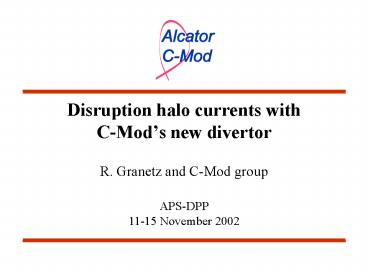Disruption halo currents with C-Mod PowerPoint PPT Presentation
1 / 14
Title: Disruption halo currents with C-Mod
1
Disruption halo currents withC-Mods new divertor
- R. Granetz and C-Mod group
APS-DPP 11-15 November 2002
2
Disruption halo currents increase stress on
structures
- High transient voltages drive halo current
through plasma SOL - Halo current completes circuit through
conducting structure - Jhalo ? B? generates extra forces on vessel wall,
particularly inboard wall - Toroidal asymmetry of Jhalo increases peak loading
3
C-Mod inboard divertor has changed
- Shape has changed (nose job)
- Structurally strengthen inner vessel wall
(girdle) - New disruption instrumentation added
- Some previous disruption instrumentation removed
4
Disruption geometry with previous divertor
Halo current flowing
- Most of SOL contacted both inboard and outboard
divertors - Therefore most of the halo current current flowed
from inboard to outboard through vacuum vessel
5
Halo current rotation was ubiquitous
- Halo current asymmetry usually rotated at ?1 kHz
for 1-2 ms - Total halo current was uni-directional (i.e.
unipolar) - No difference between midplane- quench
disruptions and VDE disruptions
6
Previous halo current scaling
- Peak Ihalo ? 0.63 Ip/q95 (or equivalently 1.08
10-6 Ip2/B?)
7
Halo current instrumentation onnew inboard
divertor
New halo Rogowski coils (10 toroidal sectors)
8
Typical halo currents for VDE disruptions with
new divertor
- Lower magnitude
- n1 asymmetry (as before), but usually not
rotating - Total halo current changes sign during quench !
9
Halo currents are lower with new divertor
Previous scaling
10
VDE disruptions with new divertor
Halo current flowing
- Much of scrape-off layer misses new inboard
divertor
11
Typical halo currents for midplane-quench
disruptions with new divertor
- Little or no n1 asymmetry
- Total halo current is nearly unipolar
12
Midplane-quench disruptionswith new divertor
- Plasma stays diverted until almost gone ? halo
current cant short from inner to outer divertors
13
Summary of differences
Different halo current characteristics with new
inboard divertor
Comments/Explanations
- Lower magnitude
- Smaller nose descending plasma remains farther
away
- Total halo current changes polarity during VDE
quenches
- Current may enter wall above inboard divertor and
exit through face of inboard divertor
- VDEs have n1 asymmetry, but dont usually rotate
- ? (Dont even know why they used to rotate)
- Mid-plane disruptions and VDEs differ in
toroidal asymmetry
- VDEs limit on outboard divertor, Mid-plane
disruptions remain diverted.
14
Conclusion
- The shape of the divertor strongly affects halo
current characteristics!

